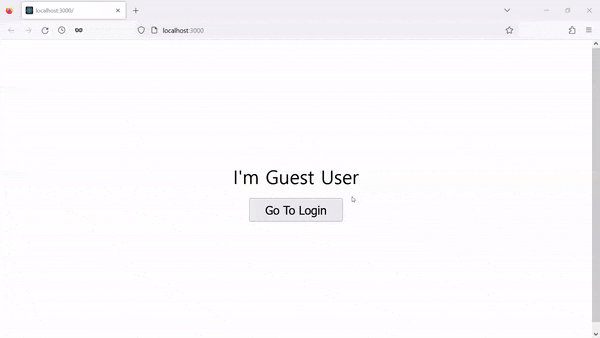Session is stored and used to communicate clients and servers for a certain amount of time. Today, we will talk about how to implement session in Next.js application. We will create a simple application to understand how it works in Next.js. Let's dig into it.
Prerequisite
- Basic knowledge about Next.js and typescript
Install
We will use iron-session because it is featured in the Next.js documentation and it is easy to apply. Install iron-session in the Next.js application:
npm install iron-sessionGoal
We will create two pages. One is the index page and the other is login page. In the index page, we will display a username if any user is logged in or a text saying I'm Guest User as a default. What will happen in the login page is that we will make a request to an API to log in. If the request succeeds, it will redirect to the index page. Finally, we will need the API to handle log-in request, which is where we save session data.
The goal here is once a user is logged in, we will see if their name shows and when the page is refreshed, the name stays still for a certain amount of time.
App Structure
This is the structure of the core part under the project folder:
├── lib
│ ├── withSession.tsx
├── pages
│ ├── api
│ │ ├── login.tsx
│ ├── login
│ │ ├── index.tsx
│ ├── index.tsx
│ ├── _app.tsxlib/withSession.tsx
We will create two wrappers that handle session behind the scene. One is for the API route and the other is for getServersideProps function as you can infer from their names.
There are a few things to talk about.
- Since we use typescript, we should let typescript know what we will store in session - username is added to IronSessionData interface here
- We should put a password that is at least 32 character long for the option of the session.
- We can set up cookieOptions based on our needs
import { GetServerSidePropsContext, GetServerSidePropsResult, NextApiHandler } from "next";
import { withIronSessionApiRoute, withIronSessionSsr } from "iron-session/next";
declare module "iron-session" {
interface IronSessionData {
username?: string;
}
}
const sessionOptions = {
password: "cookie-password-must-be-at-least-32-character-long",
cookieName: "my-cookie-name",
// secure: true should be used in production (HTTPS) but can't be used in development (HTTP)
cookieOptions: {
secure: process.env.NODE_ENV === "production",
maxAge: 100
},
};
export function withSessionRoute(handler: NextApiHandler) {
return withIronSessionApiRoute(handler, sessionOptions);
}
export function withSessionSsr<P extends { [key: string]: unknown } = { [key: string]: unknown } >(
handler: ({req, res}: GetServerSidePropsContext) => GetServerSidePropsResult<P> | Promise<GetServerSidePropsResult<P>>,
) {
return withIronSessionSsr(handler, sessionOptions);
}pages/index.tsx
Notice that getServerSideProps is passed to the session wrapper we have created an argument. In getServerSideProps, session data can be accessed and it will be passed to the Home component as a prop. If any username is stored in the session, the username will be displayed on the client side.
import Link from "next/link";
import { withSessionSsr } from "../lib/withSession";
interface Props {
username: string;
}
export default function Home({ username }: Props) {
return (
<div>
<div className="name">I'm {username || "Guest User"}</div>
<button><Link href={"/login"}>Go To Login</Link></button>
</div>
)
}
export const getServerSideProps = withSessionSsr(
async function getServersideProps({ req, res }) {
try {
const username = req.session.username || "";
return {
props: {
username: username
}
}
}
catch(err) {
console.log("page Home error", err);
return {
redirect: {
destination: '/login',
statusCode: 307
}
}
}
}
)pages/login/index.tsx
Login component will handle user information and make a request to api/login route. If any user is logged in, it will redirect to the Home route.
import { FormEvent, useRef, useEffect } from "react";
import { useRouter } from "next/router";
import { withSessionSsr } from "../../lib/withSession";
interface Props {
username: string
}
export default function Login({ username }: Props) {
const router = useRouter();
const emailRef = useRef<HTMLInputElement>(null);
useEffect(() => {
if(username) {
router.push({pathname: "/"});
}
}, [])
async function login(event: FormEvent<HTMLFormElement>) {
event.preventDefault();
if(!emailRef.current) return;
const email = emailRef.current.value;
try {
const options = {
method: "POST",
headers: {
"Content-Type": "application/json"
},
body: JSON.stringify({ email: email })
}
const response = await fetch('/api/login', options);
if(response.status !== 200) throw new Error("Can't login")
router.push({ pathname: "/" });
}
catch(err) {
console.log(err);
}
}
return (
<div>
<form onSubmit={login}>
<input type="text" ref={emailRef} />
<button type="submit">Login</button>
</form>
</div>
)
}
export const getServerSideProps = withSessionSsr(
async function getServersideProps({ req, res }) {
try {
const username = req.session.username || "";
return {
props: {
username: username
}
}
}
catch(err) {
console.log(err);
return {
redirect: {
destination: '/login',
statusCode: 307
}
}
}
}
)pages/api/login.tsx
This endpoint takes a log-in request from the client and find a user from a database and then, save the information in session if the matching user is found - As you know, instead of using mockUsers as shown below, you should implement a database in the endpoint in a real world.
import { withSessionRoute } from "../../lib/withSession";
const mockUsers = [
{
username: "Admin User",
email: "admin@gmail.com"
},
{
username: "Just User",
email: "justuser@gmail.com"
}
];
export default withSessionRoute(
async function handler(req, res) {
switch (req.method) {
case "POST":
const { email } = req.body;
const loggedInUsername = mockUsers.find(user => user.email === email);
if(!loggedInUsername) {
res.status(404).send("Can't find the user");
break;
}
req.session.username = loggedInUsername.username;
await req.session.save();
res.status(200).send('Found the user');
break;
default:
res.status(405).end(`${req.method} Not Allowed`);
break;
}
}
);Run
Run the code and try like this:

As you can see, when a user named Admin User is logged in and then, the page is refreshed, it still shows Admin User because the data is now stored in the session for an amount of time we set.
Although this practice is simplified to solely explain how the session works in Next.js, I hope you have grasped the core concept and elaborate it based on your projects.
THANKS FOR READING. SEE YOU NEXT TIME!
